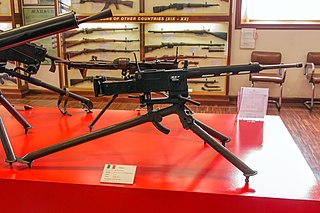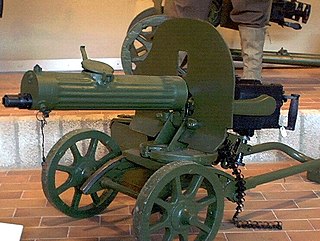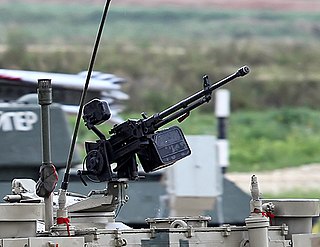 W
WA heavy machine gun or HMG is a belt-fed machine gun firing full-powered/magnum cartridges, that is designed to be more powerful and significantly more massive than light, medium or general purpose machine guns. As the name implies, heavy machine guns are typically not man-portable by infantry, and therefore require mounting onto a weapons platform to be operably stable or tactically mobile.
 W
WThe Mauser 13.2mm TuF cartridge, was a major step in the development of anti-tank cartridges, being the first one designed for the sole purpose of destroying armored targets.
 W
WThe Mitragliatrice Breda calibro 8 modello 37 was an Italian Medium machine gun produced by Breda and adopted in 1937 by the Royal Italian Army. It was the standard machine gun for the Royal Italian Army during World War II, and continued to be used by the Italian Army after the conflict. The Breda 37 was meant as company/battalion support as compared to the more troublesome Breda 30 meant for squad/platoon support, and proved far more effective in combat, though possessing some of the same problematic features of the Breda 30.
 W
WCkm wz. 30 is a Polish-made clone of the American Browning M1917 heavy machine gun. Produced with various modifications such as greater caliber, longer barrel and adjustable sighting device, it was an improved although unlicensed copy of its predecessor, and was the standard machine gun of the Polish Army since 1931.
 W
WThe DShK 1938 is a Soviet heavy machine gun with a V-shaped "butterfly" trigger, firing the 12.7×108mm cartridge. The weapon was also used as a heavy infantry machine gun, in which case it was frequently deployed with a two-wheeled mounting and a single-sheet armour-plate shield. It took its name from the weapons designers Vasily Degtyaryov, who designed the original weapon, and Georgi Shpagin, who improved the cartridge feed mechanism. It is sometimes nicknamed Dushka in Russian-speaking countries, from the abbreviation.
 W
WThe Fiat–Revelli 35 was an Italian machine gun, a modified version of the Fiat–Revelli Modello 1914, which had equipped the Italian Army of World War I.
 W
WThe Nkm wz.38 FK was a 20 mm heavy machine gun produced in inter-war Poland. It was used both in anti-air and anti-tank role and was also adapted for tank use and mounted on some TKS tankettes. Mass-produced in 1938 and 1939, it was used extensively during the September Campaign.
 W
WThe 13.2 mm Hotchkiss machine gun was a heavy machine gun designed and manufactured by Hotchkiss et Cie from the late 1920s until World War II and saw service with various nations' forces, including Italy and Japan where the gun was built under license.
 W
WKarabin maszynowy wz. 36, also known as Karabin lotniczy uniwersalny wz. 36 was a Polish 7.9 mm calibre aerial machine gun of the 1930s. It was a further modified version of Karabin maszynowy wz. 33, itself a modification of the successful Ckm wz.30 multi-purpose HMG.
 W
WThe KPV-14.5 heavy machine gun is a Soviet designed 14.5×114mm-caliber heavy machine gun, which first entered service as an infantry weapon in 1949. In the 1960s, the infantry version was taken out of production because it was too large and heavy. It was later redesigned for anti-aircraft use, because it showed excellent results as an AA gun, with a range of 3,000 meters horizontally and 2,000 meters vertically against low flying planes. It was used in the ZPU series of anti-aircraft guns. Its size and power also made it a useful light anti-armour weapon on the BTR series of vehicles and the BRDM-2 scout car.
 W
WThe M45 Quadmount was a weapon mounting consisting of four of the "HB", or "heavy barrel" .50 caliber M2 Browning machine guns mounted in pairs on each side of an open, electrically powered turret. It was developed by the W. L. Maxson Corporation to replace the earlier M33 twin mount. Although designed as an anti-aircraft weapon, it was also used against ground targets. Introduced in 1943 during World War II, it remained in US service as late as the Vietnam War.
 W
WThe Maschinengewehr 08, or MG 08, was the German Army's standard machine gun in World War I and is an adaptation of Hiram S. Maxim's original 1884 Maxim gun. It was produced in a number of variants during the war. The MG 08 served during World War II as a heavy machine gun in many German infantry divisions, although by the end of the war it had mostly been relegated to second-rate fortress units.
 W
WThe Maschinengewehr Modell 1911 or MG 11 is a Swiss heavy machine gun which was introduced before and during World War I. The MG 11 has a narrow constructive relationship with the German MG 08 heavy machine gun.
 W
WThe MG 131 was a German 13 mm caliber machine gun developed in 1938 by Rheinmetall-Borsig and produced from 1940 to 1945. The MG 131 was designed for use at fixed, flexible or turreted, single or twin mountings in Luftwaffe aircraft during World War II.
 W
WThe PM M1910 is a medium machine gun that was used by the Imperial Russian Army during World War I and the Red Army during Russian Civil War and World War II. Later the gun saw service in the Korean War and the Vietnam War.
 W
WThe RPL-20 is a prototype light machine gun developed by Kalashnikov Concern for the Russian Military. Though designed in response to feedback following the purchase and testing of the company's magazine-fed RPK-16 light machine gun, the RPL-20 is an entirely new design, utilizing an open-bolt, belt-fed action in lieu of the closed-bolt, magazine fed operation typical to Kalashnikov-pattern weapons. It is anticipated to serve as a squad automatic weapon in Russian military use, supplementing the heavier-caliber PK machine guns currently used for suppressive fire while still providing a higher practical rate of fire than is possible with RPK-based weapons. The RPL-20 was unveiled at the Army-2020 event in late August, 2020.
 W
WThe Maschinengewehr (Schwarzlose) M. 7, also known as the Schwarzlose MG, is a medium machine-gun, used as a standard issue firearm in the Austro-Hungarian Army throughout World War I. It was utilized by the Dutch, Greek and Hungarian armies during World War II. It was routinely issued to Italian colonial troops, alongside the Mannlicher M1895 rifle.
 W
WThe Type 1 Heavy Machine Gun was a heavy machine gun used by the Imperial Japanese Army during the Second World War starting from 1941.
 W
WThe Type 3 heavy machine gun , also known as the Taishō 14 machine gun, was a Japanese air-cooled heavy machine gun.
 W
WType 3 was a Japanese Navy aircraft machine gun used during World War II. It was based on the American M2 Browning machine gun but used the 13.2x96mm Hotchkiss cartridge.
 W
WThe Type 77 heavy machine gun is described as China’s first generation designed 12.7 mm heavy machine gun.
 W
WThe Type 92 Heavy Machine Gun was a Japanese heavy machine gun, related to the Hotchkiss machine gun series. It entered service in 1932 and was the standard Japanese heavy machine gun used during World War II. Known for its reliability, it was used after the war by various forces in East Asia. Designed by Kijiro Nambu and built by Hino Motors and Hitachi, its total production was about 45,000 guns.
 W
WThe W-85 heavy machine gun is a gas-operated heavy machine gun designed in the People's Republic of China. It fires the Soviet-designed 12.7×108mm round. The W85 is not to be confused with the Type 85, another Chinese machine gun of the same caliber but of a different design.
 W
WThe ZB-60 was a heavy machine gun designed by Zbrojovka Brno in Czechoslovakia during the 1930s. Weapons acquired after the German occupation of Czechoslovakia in March 1939 were taken into Wehrmacht service as the 15 mm FlaMG 39(t); Former Yugoslav guns were designated as the 15 mm FlaMG 490(j). The Germans used them as light anti-aircraft guns during World War II. The British developed their 15 mm Besa Mk I from the ZB-60 for service on armored fighting vehicles.